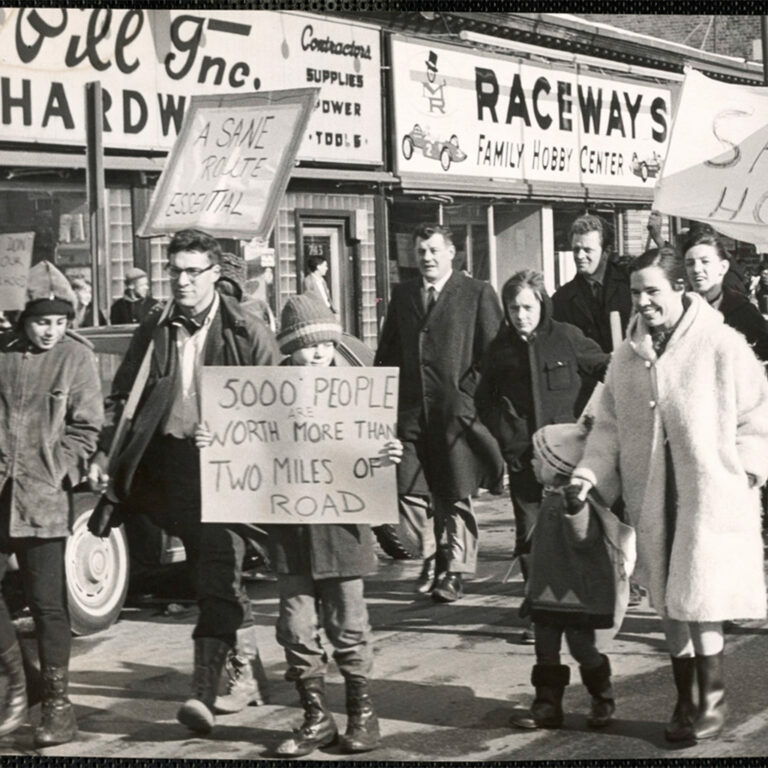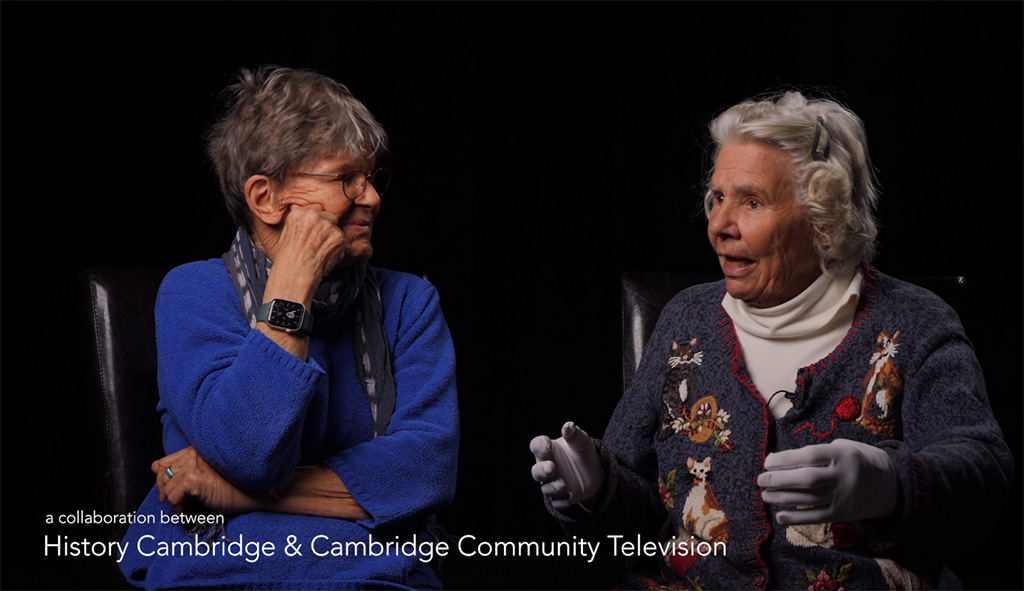
‘Beating the Belt’ highlights women’s activism fighting against state’s superhighway project
Above image: Community activists, including Antis Benfield, march to the State House to protest the Inner Belt in 1966. (Photo: Cambridge Historical Commission, Cambridge Photo Morgue Collection, via Digital Commonwealth)
By Beth Folsom
One day in 1965, Cambridgeport resident Rebecca Hall heard a knock at her door and opened it to find her neighbor, Antis Benfield, with a petition against the proposed Inner Belt project. In the early 1960s, the state of Massachusetts had created a plan to expand the interstate system by creating a vast, multilane highway that would run through a number of Boston-area neighborhoods, including the part of Cambridge where Hall and Benfield lived. Stay-at-home mothers with young children, the women forged a deep friendship as they fought alongside other community activists in a yearslong battle against the Inner Belt and the destruction of thousands of local homes and businesses.
Benfield and Hall’s story is chronicled by Cambridge Community Television in the short film, “Beating the Belt: How Women’s Activism Helped Save a Cambridge Neighborhood.” Filmmaker Peter Levine admits he knew little about the Inner Belt when he started the project, but that it was inspiring to see the extent to which community organization and activism had prevailed in the struggle against the highway project. The film opens with a quote from Hall, who calls her participation in the Inner Belt protests “probably the most important thing I’ve done in my life.” Benfield notes that women – particularly young mothers – were at the forefront of the movement because, with few of them working outside the home, they had the time and energy to devote to organizing and participating in marches, meetings and protests. As the group charged with protecting the interests of the home and family, wives and mothers were especially drawn to the cause of preserving the Cambridgeport neighborhood, she said.
In 1965, Massachusetts rescinded its previous veto of the Inner Belt project, putting more than 13,000 Cambridge residents and businesses at risk of being evicted – their property would have been seized by eminent domain and demolished to make way for the new superhighway. That year, Benfield was among the first to organize, going door-to-door in Cambridgeport to gain support and petition signatures from her neighbors. The local press covered with a mixture of respect and bemusement the eventual march of “housewives and kids” from Cambridgeport to the State House under the banner “Cambridge is a City, Not a Highway!” which would become the movement’s slogan in the years to come.
From 1965-1967, as plans for construction ramped up at the state level, Benfield, Hall and their compatriots were hard at work rallying other residents, attending meetings and protests and gathering signatures in opposition. In the spring of 1967, two busloads of mostly women and children traveled from Cambridge to Washington, D.C., to protest the project at the national level. Two years later, in what is arguably the most famous of the Inner Belt protests, activists marched from Cambridge City Hall to the State House led by city councillor (and future Cambridge mayor) Barbara Ackermann, who rode a horse dressed as Paul Revere to draw attention to the cause.

Although it took six years, the protests were ultimately successful when, in 1971, Massachusetts Gov. Francis Sargent called a moratorium on highway building along Route 128. In 1972, Sargent announced the permanent cancellation of the Inner Belt project. As Hall remembers it, the members of her activist community drifted apart after the defeat of the Inner Belt, with many taking on other projects but no formal closure to their years of hard work and dedication. Finally, in 2022, Benfield, Hall, Inner Belt historical Steve Kaiser, former Gov. Michael Dukakis and other stakeholders gathered for a virtual conversation commemorating the 50th anniversary of the Inner Belt’s defeat, which can be viewed here.
Levine reflects on his experience making “Beating the Belt,” maintaining that “the heart of this project was [Hall and Benfield’s] friendship. It’s another example of how community movements seem to take off when the people involved truly care about each other.”

“Beating the Belt: How Women’s Activism Helped Save a Cambridge Neighborhood” can be viewed here.
Karilyn Crockett’s book, “People Before Highways: Boston Activists, Urban Planners, and a New Movement for City Making”explores the Inner Belt in the context of local highway-building movements. For information about the Inner Belt project and its defeat, visit History Cambridge’s Inner Belt Hub.
Beth Folsom is programs manager for History Cambridge
This article was originally published in our “Did You Know?” column in Cambridge Day.






